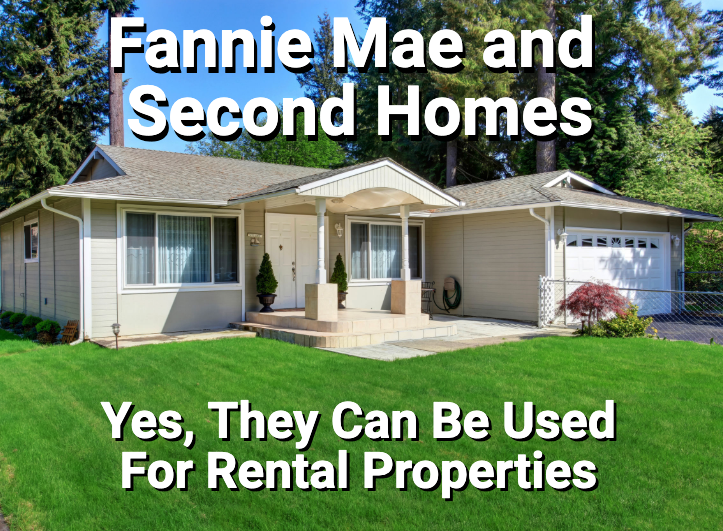Fannie Mae is rewording their guidelines and requirements for loans to ensure people understand an important point: if you have a Fannie Mae mortgage on a second home, that house can be used as a rental property.
Rarely are government organizations clear and concise in their communication. Usually selecting complex legalese, guidelines and regulations issued by these agencies and administrations, no matter how important, are often difficult to understand.
One example is the Fannie Mae guidelines for renting out a second home. Previously, most people assumed that you can’t use a second property as a rental if that house has a mortgage supported by Fannie Mae. This assumption came because the language from Fannie Mae was hard to understand.
Now, Fannie Mae has rewritten the guidelines (but not actually changed the rules) to help people better understand converting their second home to a rental property.
To be honest, the language is still complex (it clearly comes from a government institution), but it’s far better, and far clearer than previous versions.
Regardless of language, the bottom line is this: you can rent out your second home, even if you have a Fannie Mae loan on the property.
Let’s Be Clear: You Can Rent Your House with a Fannie Mae Second-Home Rider
The new language is outlined in the Second Home Rider from Fannie Mae. While the rules are now more clear, they do require a bit of explaining.
Explaining the Rules: Fannie Mae Second Homes
Initial 12 Months: Short-Term Renting Only

Through the first year, you will have to keep the property in mostly personal use. Of course, wording like “primarily” can create confusion by itself, but basically you can only do short-term renting during the first year of ownership. Exceptions are available and they can be discussed with a lending agent, but if you are using a Fannie Mae loan for your second home, you can only rent it out on a short term basis. Once the first 12 months are complete, you will have more flexibility on how and when you can rent out the second home.
After Second Year: Longer Rentals Allowed
Once you have owned the property for a year, you will be able to rent out the second home on a longterm basis. Many people don’t realize it, but this was always allowed by Fannie Mae, but because of the complex language, it was not understood.
No Property Management Companies
While you can rent out your property to longterm tenants after the first year of ownership, the guidelines specifically state that you are not allowed to use rental-management companies. This means that if you choose to rent the property, you will have to be responsible for all the tasks, including finding renters, collecting checks, and maintaining the property. You can hire out certain tasks, such as yard work or landscaping, but you will need to be the one performing overall management of the property itself.
No Timeshares
The same section that discusses property management companies also discussed timeshares. The result is the same: they are not allowed. The restriction is due to the fact that timeshares tend to have a greater risk, and lenders are likely to prohibit them on any loan, even if that loan does not involve Fannie Mae.
Whether your second home is a beach house or a cabin in the woods, you can rent it out when you have a Fannie Mae loan.
Bottom Line: Low-Interest Fannie Mae Loans are Available for Investment Properties
Fannie Mae has not changed the rules, but they have made it clear that their loans are options for people who want to purchase an investment property, as long as the investor doesn’t mind waiting a year.
This allows for loans that often have lower rates and better terms than other investment-financing options. Thanks to the clarity, we expect Fannie Mae loans to become an attractive option for investments.
With this new writing, Fannie Mae has greatly clarified their rules. It’s now perfectly clear that you can use a Fannie Mae loan to purchase a second home that will be used as a rental property. As long as you wait one year, you can rent it out on a longterm basis, and even in the first year, short-term rentals are possible as long as you use the property primarily for your personal use and enjoyment.
Investors can use the benefits of Fannie Mae, including lower interest, to purchase a rental property.
Why Are Fannie Mae Loans Ideal for Secondary Homes and Investment Properties?
Although it is traded publicly, Fannie Mae is an organization sponsored and supervised by the federal government. The primary mission of this company is not profits, but the support of American homeownership, which it does by purchasing loans on the open market.
Their function is complex, but the company purchases loans from lenders and takes on the financial benefits as well as the risk. Lenders can sell the loans and take the risk off their shoulders while making a quick profit. Essentially, Fannie Mae makes loans more available for numerous borrowers.
Because lenders can sell to Fannie Mae and thereby reduce risk, the interest on these loans can be less. Therefore, it’s useful for borrower to use Fannie Mae loans on their mortgages. Previously, Fannie Mae loans were thought to be unavailable to anyone who wanted an investment property, but with the the recent clarification, it’s obvious that these loans are in fact an option. While the loan will be processed as if you were purchasing a second home, that property can be used to generate income, and it is often beneficial to use these loans for your purchase.
Create a Better Investment Portfolio with San Diego Purchase Loans
If you are interested in using a Fannie Mae loan to purchase a second home, contact San Diego Purchase Loans. We have the experience and knowledge to help you get the right loan for your specific needs!


